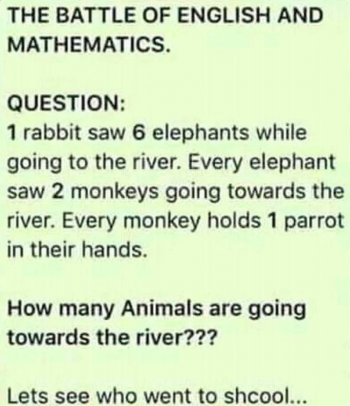Ask Professor Puzzler
Do you have a question you would like to ask Professor Puzzler? Click here to ask your question!
Laina asks for an explanation of the puzzle shown below.

The text reads: "THE BATTLE OF ENGLISH AND MATHEMATICS.
1 rabbit saw 6 elephants while going to the river.
Every elephant saw 2 monkeys going towards the river.
Every monkey holds 1 parrot in their hands.
How many animals are going towards the river???
Lets see who went to shcool..."
First, I doubt I'll be able to solve this, since I never went to shcool...
However, my answer is, simply, there is no solution, because there is not enough information given.
This is like a poor man's version of the "St. Ives" riddle. In case you don't know that riddle, it goes like this: "As I was going to St. Ives, I met a man with seven wives. Every wife had seven sacks, every sack had seven cats, every cat had seven kitts. Kitts, cats, sacks, wives, how many were going to St. Ives?"
With the St. Ives riddle, the narrator meets a man with seven wives. The word "meets" strongly implies* that the man with seven wives was going in the opposite direction.
Notice, though, that in our question here, it does not say that the rabbit "met" the elephants, only that he saw them, which could certainly mean that he overtook them as they were also on their way to the river. We simply don't know what the elephants are doing, and therefore there is not enough information to definitively answer the question.
I could end there, because the answer is indeterminate. However, I think it's worth exploring the question further.
The next question that arises is, how many monkeys are there? The two most common answers to this are two and twelve.
The first answer comes from assuming that each elephant saw the same two monkeys, and the second answer comes from assuming that each elephant saw two monkeys that none of the others saw. The most compelling argument for "two" as the answer is that the problem uses the word "every" instead of "each." The word "every" is a group word, implying the group as a whole did something. Thus, the group, as a whole, saw two monkeys. It's an interesting argument, but not all that convincing; grammarly states that each and every can be used interchangeable in some circumstances, and Cambridge Dictionary gives us such an example:
Each person has a bicycle.
Every person has a bicycle.
Both of these statements mean that there is a bicycle for each person. If we aren't going to assume that every person has the SAME bicycle (meaning, of course, that there's only one bicycle), then we can't assume that every elephant saw the same two monkeys.
Nor can we assume that every elephant saw two distinct monkeys that none of the others saw.
Therefore, there must be somewhere between 2 and 12 monkeys, inclusive, but the exact quantity of monkeys is unknown. Giving us, once again, an indeterminate answer.
There was another argument I saw for two monkeys - some people were saying, "since the problem doesn't state explicitly, implicit rules apply, making it two." Implicit rules? What is that? Is it just a fancy way of saying, "Since they didn't specify, I get to pick whichever makes the most sense to me, and call it the 'default' meaning."?
Regarding the parrots, it's interesting to me that the people who present the "each vs. every" argument are inconsistent; If "every elephant saw two monkeys" means that the group as a whole saw two monkeys, then "every monkey holds one parrot" means that the group as a whole is holding a parrot, and there is one parrot, instead of two parrots. It seems to me that you can't have it both ways.
Finally, there really is no battle between English and Mathematics. I've been hired to write competition math problems in at least three different states, and I can tell you that English and Mathematics work side-by-side to make a good problem. Ambiguity in the use of English makes the problem unsolvable. If this problem showed up in any math competition anywhere, the appeals committee for the competition would be inundated with appeals written by students arguing for different answers. The appeals committee would have to accept multiple answers or throw the problem out entirely (I saw this happen just a couple weeks ago at a state math competition; because of one missing word in a problem, the problem was thrown out, and no one received any points for it).
I asked my problem proofreader what he would do if I sent this problem to him to proofread. He assured me that he would throw it out. He also said:
"I think this is a wonderful problem for a class discussion, but not for any type of grade or for a competition. There is far too much ambiguity for it to be a problem with a well defined answer."
* Even the St. Ives problem is ambiguous; there isn't actually a solid reason to conclude that the man with seven wives is going in the opposite direction; the narrator could have simply caught up with the man (all things considered, he's probably going fairly slowly!) and struck up a conversation with him. That is an appropriate usage of the word "meet," and the St. Ives problem is therefore ambigious.

